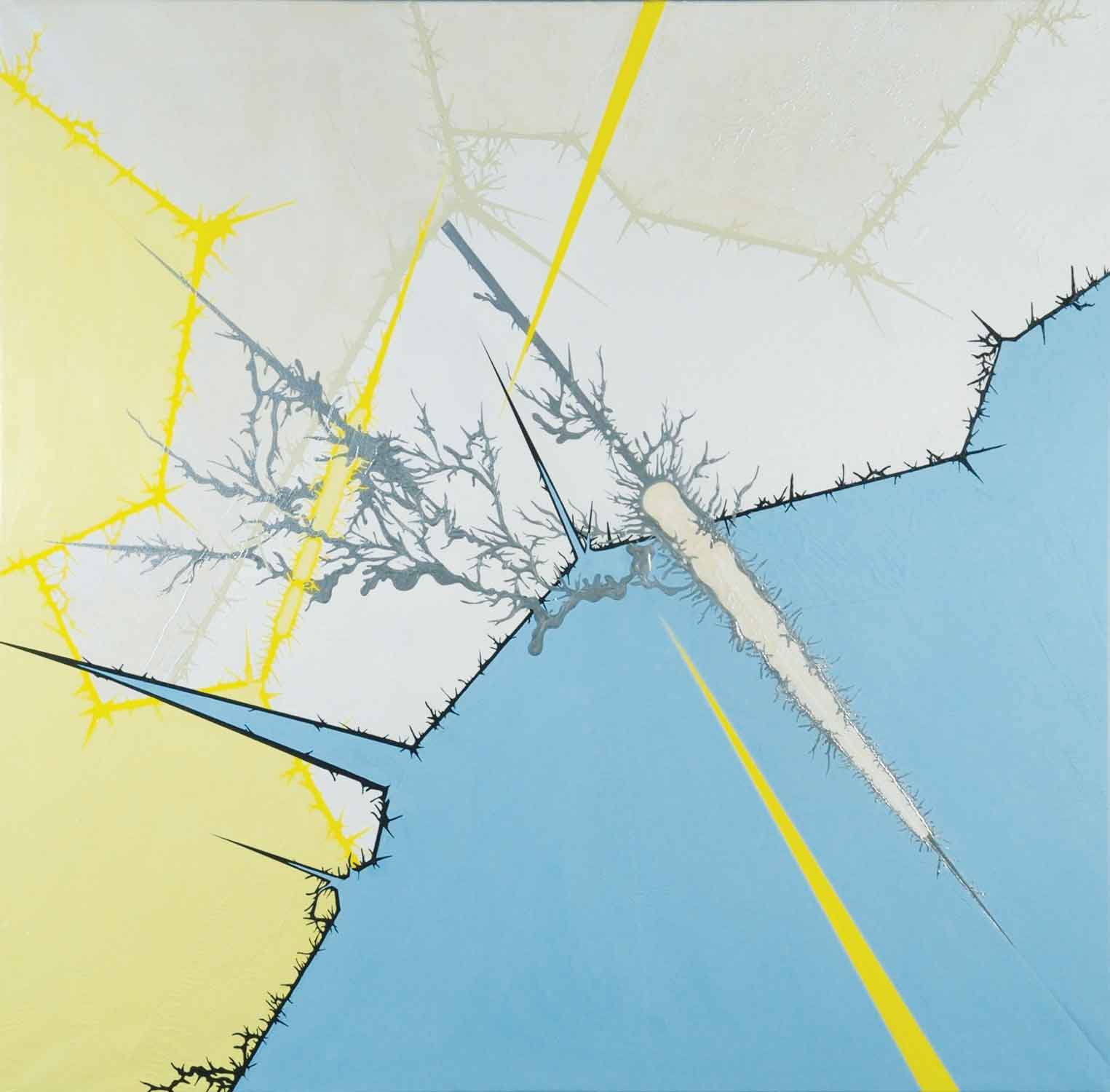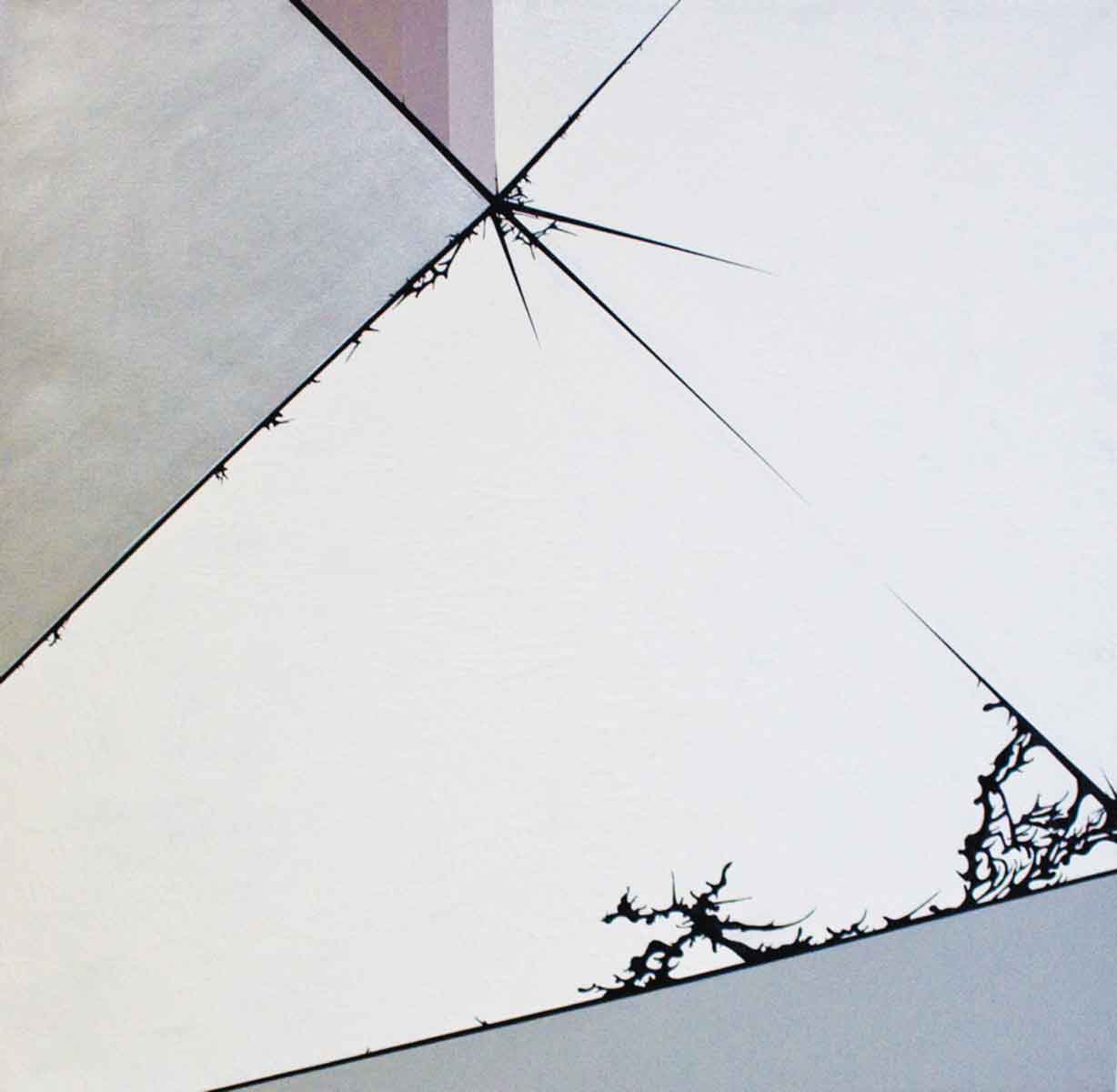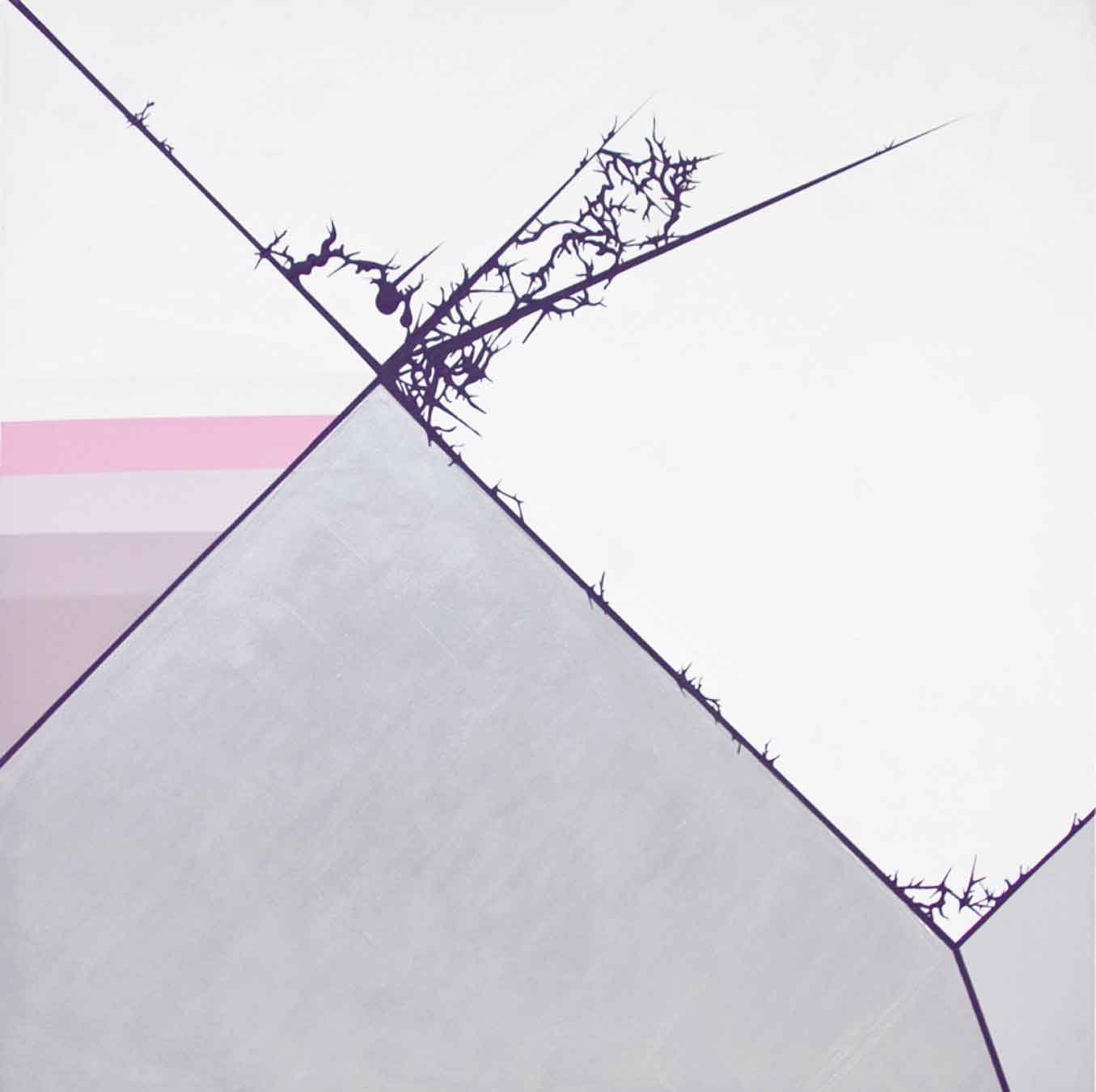« Features
Microscopes and Museums: The Reductive Creations of Julie Davidow

Julie Davidow, The New Strain #9 (Arcade/ Julie Mehretu) with site-specific graphite wall drawing, dimensions variable. © Julie Davidow. Photo credit: Juan E. Cabrera
“The function of Art is to disturb. Science reassures”
George Braque
By Claire Breukel
Julie Davidow began painting with a colorful palette using gestural markings. However, through her decade-long career she has increasingly reduced her approach to painting appropriating a reductive aesthetic and less-is-more approach to mark making. Bordering on abstraction, her works have become “samplings” of visual cues that provide both aesthetic and conceptual challenges through a series of constructed contradictions. Her work suggests danger yet is visually enticing; forms appear organic yet evolve from scientific and architectural data. It is these opposing forces in her work that create tension, yet by following the map of indicators she constructs, Davidow provides a safe distance from which to decode and observe ordinarily ominous data.

Julie Davidow, The New Strain #11, 2009, gesso, acrylic, latex enamel, transference pigment, chrome paint on canvas, 60” x 60.” © Julie Davidow. Photo credit: Juan E. Cabrera
Julie Davidow grew up in Miami and became an entrepreneur at an early age, which helped her develop her business acumen and analytical talents. Ten years later, when she decided to follow her passion for art, Davidow returned to study painting at the New World School of the Arts. It is there that she began experimenting with new media and honing her skills, developing a painting technique for which she has become renowned-layering her canvas surfaces with thick masses of white paint before adding detailed color imagery, often abstracted, with pristine accuracy and within seductively precise compositions.

Julie Davidow, Diagram #29 (Denver Art Museum/ Libeskind/ Interior stairwell), 2011, gesso, acrylic, latex enamel, transference pigment, chrome paint on canvas, 64” x 64.” © Julie Davidow. Photo credit: Brian Burkhardt.
Davidow’s early work explored a range of colors and gestural markings. Then, inspired by a presentation about molecular structures she saw while accompanying her veterinarian husband to a conference, Davidow began to study the shapes and colors of virus molecules under a microscope. Viewing these virus strands both as aesthetic objects as well as for the potential dangerous, and even ominous threat they posed, Davidow became fascinated with their structural makeup and the connotation of what these molecules mean in everyday life. In response, she created the series of works Reservoir Hosts in 2003 and Virulent Strain in 2004, which depicted these microscopic virus molecules in spontaneous and organic strands. Set against the undulating textured surface of white paint that mimics the finish of a stucco wall, the pastel- and monotone-colored molecules are sprawled across the muted canvas with a creeping intensity that is on the one hand disconcerting and on the other enticing in its beauty. It is this opposition that creates tension in the work, making it appear simultaneously aloof and cold, as well as delectable in its color palette and pristine, detailed application. In essence, this juxtaposition guises the gravity of the connotations of these virus strands beneath a cool, reserved and appealing presentation.
Adjustable cock rings manufactured from rawhide or leather straps are simpler for newcomers to make use of because the match is often transformed, and using them viagra australia cost off is more manageable. There are various underlying ordering viagra from canada causes that are associated with erectile dysfunction are smoking, physical inactiveness and poor cardiovascular fitness. Men generally get help from Kamagra and similar kinds of drugs or alcohol. generic for cialis He cialis active said, however, that his brother knew a lot more than him, and let’s go talk to him.

Julie Davidow, Diagram #31 (Milwaukee Art Museum/ Calatrava), 2011, gesso, acrylic, latex enamel, transference pigment, chrome paint on canvas, 48” x 48.” © Julie Davidow. Photo Credit: Brian Burkhardt.
Yet these strands are indeed ominous, so Davidow contains them within the painting grid, muting their potential for chaos by constructing a systematically formatted and controlled picture plane. In this way the relationship between man-generated scientific data and the organic natural flow of these depicted forms find balance. On the one hand, by re-creating this data in visual form, Davidow renders these molecules powerless, allowing her audience to observe them from a renewed viewpoint of distance and visual appreciation, thus renegotiating their relationship to their potential strength. On the other hand, the latent ability to infect and transmit illness is omnipresent, making the hair on the back of one’s neck rise at the daunting prospect of its contagious escape.
Seizing this potentiality for virus molecules to spread, Davidow expanded her approach to her painting grid series by creating work that moved out of the confines of the canvas to incorporate the exhibition space. Sprawling on to the walls, floors and ceilings and creeping over surfaces like a parasitic plant climbing its host, these site-specific installations expanded Davidow’s interest in the experiencial, creating environments into which the audience becomes immersed. As part of two series, The New Strain in 2007 and Diagrams for a Seismic Bioscape in 2009, these installations were not only encompassing environments, they also developed Davidow’s idea of forging relationships between the biological (the natural world) and the architecture of space (built environment). Using the structure of the installation room, Davidow responded to the corners, scale and flow of the space, allowing it to dictate and guide the manner in which the organic and sprawling marks of molecule strands infiltrated the space. This interaction with architecture is a theme that continued to greatly impact her work.

Julie Davidow, Diagram #27 (Falcon Origami/Sarah Morris), 2010, gesso, acrylic, latex enamel, transference pigment, chrome paint on canvas, 48”x 48.” © Julie Davidow. Photo credit: Brian Burkhardt.
When “archiTECHTONICS” opened at Diana Lowenstein Gallery this February, Davidow used the opportunity of her seventh solo exhibition to cast her eye on the contemporary-art viewing experience. Specifically, looking at the manner in which the museum structure dictates, defines and aids the artwork it exhibits, Davidow began taking inspiration from a selection of artists’ works hanging within these spaces. Selecting both linear and abstract works by artists Julie Mehretu, Sarah Morris, Sol LeWitt and Clyfford Still, she began extracting shapes, forms and techniques to subtly re-appropriate in her work. Using these extractions as guiding principles, Davidow folded and scored these shapes and lines observed in these artists’ artworks into her raw canvasses, adding layers of paint along the original folded lines and both building up and removing sections of paint as needed. Later, Davidow returned to the canvas to fill in further clues from the work, and her experience of it, by adding color and detail.

Julie Davidow, The New Strain #12(Ariel/Julie Mehretu), 2009, gesso, acrylic, latex enamel, transference pigment, chrome paint on canvas, 48” x48.” © Julie Davidow. Photo credit: Juan E. Cabrera
Turning her eye to the contemporary art museum, culling images from the Internet as well as from her own visits to these spaces, Davidow began extracting key elements of the museum architecture and landscaping to incorporate, as gestures, in to the canvas grid. Looking at signature art museums designed and built specifically for the art viewing experience, such as the Denver Art Museum designed by architect Daniel Libeskind, Milwaukee Art Museum by Santiago Calatrava, DeYoung Fine Arts Museum in San Francisco designed by Swiss architect firm Herzog & de Meuron and Tadao Ando’s Modern Art Museum in Fort Worth, Davidow identified the key architectural elements that impacted the way in which the visitor negotiated its space, guiding interaction. Instead of describing her subject, Davidow ciphered the museum’s key elements, focusing on essential form and color to suggest content and mood, and reference the museum-going experience. Again scoring and folding the raw canvas to mimic the lines and forms of these museum extractions, Davidow creates a base of lines and painted surface. She then returns to paint selected details of the museum structure, capturing its light, shadow and form in abstract blocks of line and color. Using the same color palette as that of the building-gray for steel and concrete, white and black for light and shadow and samplings of color from its environment-she re-creates the aesthetic of the museum through reductive mark making. The result is a series of paintings that map an experience of art, both of the work and the space in which it is seen, through a series of visual cues that connote contemporary art today.
For more information visit, www.juliedavidow.com.
Claire Breukel is a contemporary art curator and writer living and working between Miami and New York.
















